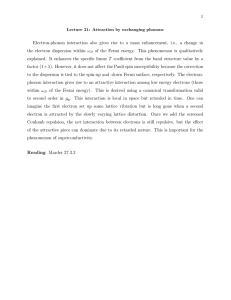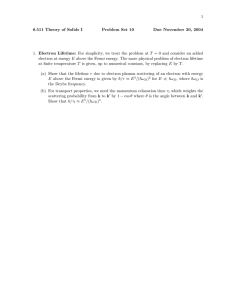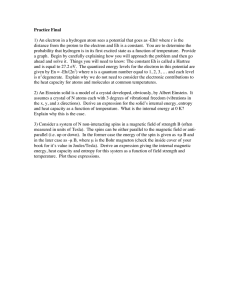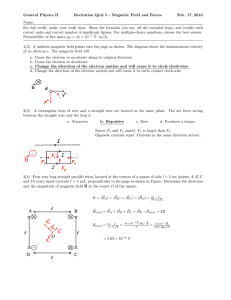In-Plane Magnetic Field Induced Anisotropy of 2D Fermi Contours
advertisement
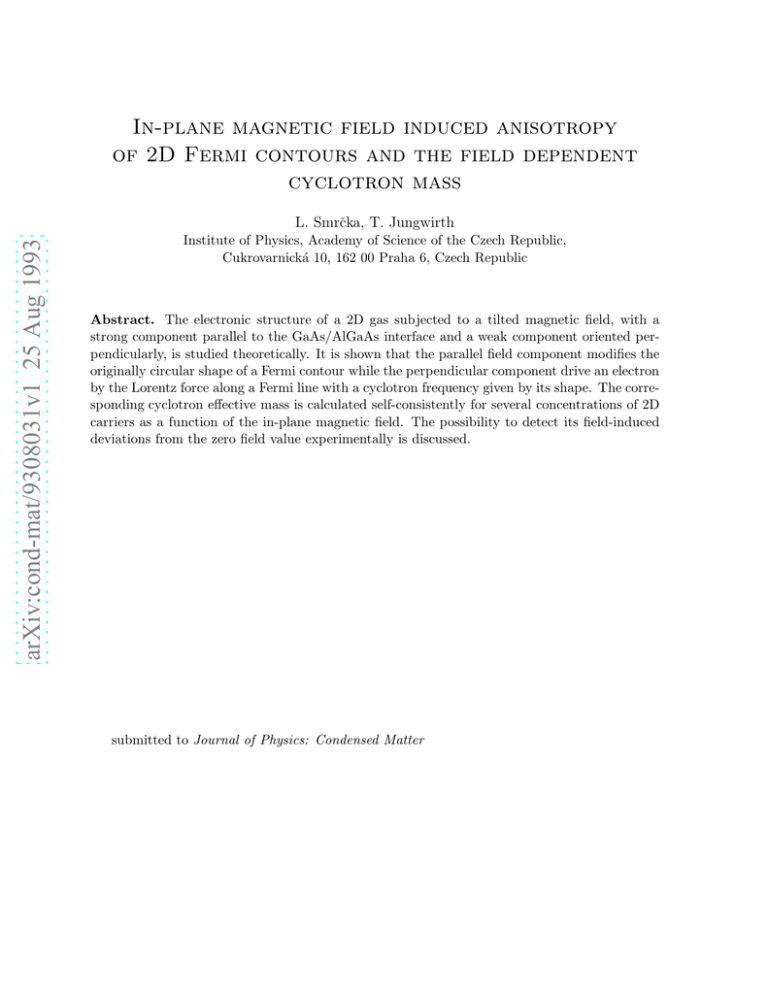
In-plane magnetic field induced anisotropy of 2D Fermi contours and the field dependent cyclotron mass arXiv:cond-mat/9308031v1 25 Aug 1993 L. Smrčka, T. Jungwirth Institute of Physics, Academy of Science of the Czech Republic, Cukrovarnická 10, 162 00 Praha 6, Czech Republic Abstract. The electronic structure of a 2D gas subjected to a tilted magnetic field, with a strong component parallel to the GaAs/AlGaAs interface and a weak component oriented perpendicularly, is studied theoretically. It is shown that the parallel field component modifies the originally circular shape of a Fermi contour while the perpendicular component drive an electron by the Lorentz force along a Fermi line with a cyclotron frequency given by its shape. The corresponding cyclotron effective mass is calculated self-consistently for several concentrations of 2D carriers as a function of the in-plane magnetic field. The possibility to detect its field-induced deviations from the zero field value experimentally is discussed. submitted to Journal of Physics: Condensed Matter 1. Introduction The energy level structure of quasi-two-dimensional systems in magnetic fields tilted with respect to the sample plane have attracted attention for many years. As shown by Maan [1] and Merlin [2] the electron spectra can be found analytically for a special case of parabolic quantum wells. This simple analytically solvable model is very useful when discussing qualitative aspects of 2D electron physics in quantum wells, but when the semi-quantitative comparison of results with experimental data is the goal of investigation, more realistic models must be used and numerical methods of calculation employed. The widely accepted approach to the electronic structure of realistic quantum wells in tilted magnetic fields, which relies on the perturbation theory, was reviewed by Bastard [3]. It can be outlined as follows. The Hamiltonian is decomposed into three parts, H = Hk + H⊥ + Hint . The first part Hk describes the motion of an electron in z−direction under the combined influence of the confining potential and the in-plane component of the magnetic field. If the in-plane field is not too strong its effect is usually included via the perturbation theory. The second part of the Hamiltonian H⊥ corresponds to the standard 2D gas subjected to the perpendicular component of the field and can be diagonalized analytically. In most situations the third coupling term Hint can be completely neglected or treated as a small perturbation. Only in certain special cases, e.g. when crossing of Landau levels from different subbands is important, the matrix elements of a coupling term must be evaluated and the Hamiltonian H diagonalized numerically [4]. In this paper we present a slightly different approach to the electron structure of quantum wells in tilted magnetic fields which is appropriate when the perpendicular component of the applied magnetic field is weak. Assuming for a moment B ≡ (0, By , 0), i.e. the field exactly parallel to the plane of 2D electron gas, the Hamiltonian Hk of an electron confined to the x − y plane by potential Vconf (z) can be written as 1 2 1 2 1 (px − eBy z)2 + py + p + Vconf (z). (1) 2m 2m 2m z Its energy spectrum is formed by subbands, momentum operators px and py commute with Hk and the eigenenergies En (kx , ky ), n = 0, 1, . . . are the functions of the quasi-continuous wavevectors kx and ky . The 2D Fermi surfaces, or more accurately the Fermi contours, are then defined separately for each subband by the equation EF = En (kx , ky ). The in-plane magnetic field By does not influence the electron motion in the y−direction while the electrons moving in the x−direction are slowed down or accelerated by the combined effect of the crossed fields By and Ez = −dVconf (z)/dz, depending on the form of Vconf (z). Consequently, it is expected that the subband separation, the 2D density of states and the shape of the Fermi contour will vary with increasing By [3]. Only recently realistic self-consistent calculations of electron energy spectra in heterostructures subjected to parallel magnetic fields have been performed [5, 6], enabling the quantitative estimate of these quantities. Let the weak perpendicular component Bz of the magnetic field be added to the strong in-plane field component By . Then the electron dynamics in the x − y plane can be described semiclassically, similarly as the dynamics of electrons in metals with non-spherical Fermi surfaces. The corresponding quasi-classical theory was originally developed by Onsager [7] and Lifshitz [8], and nowadays it is a part of standard textbooks devoted to the solid state physics (see e.g. [9]). According to this theory electrons move in the k-space along trajectories defined by intersections of a Fermi surface and planes perpendicular to the applied magnetic field. In the 2D case there is only one such line, identical with the Fermi line itself. Once the k-space orbit is known, the semiclassical theory predicts that the electron real space trajectory is of an identical shape except of the scale factor h̄/|e|Bz , and rotation by π/2. The anisotropy of the Fermi contour due to the strong parallel field thus leads to the deviation of the electron trajectory from the originally circular form. Hk = 2 The modification of the the Fermi contour shape by the in-plane magnetic field should manifest itself through the field dependence of the cyclotron effective mass mc . This important characteristics of electron energy spectra is related to the Fermi area SF surrounded by the Fermi contour by a semi-classical expression h̄2 dSF . (2) 2π dE Note that the field dependence of mc is determined by the combined influence of the in-plane component of the magnetic field and of the shape of the confining potential Vconf (z) of the quantum well and, therefore, the different structures with different quantum wells can be distinguished by measuring this quantity. Two methods are widely used to determine the cyclotron effective mass of 2D electrons confined to GaAs/AlGaAs interface: the cyclotron resonance in the infrared region of optical spectra [10] and the temperature damping of Shubnikov - de Haas oscillations [11]. To get insight into the feasibility of such experiments, we report in this paper the results of self-consistent calculations of the field dependence of the cyclotron effective mass in the electron layer confined to the interface of the standard GaAs/AlGaAs heterostructure for several concentrations of 2D carriers. mc = 2. Electronic structure in tilted magnetic fields As mentioned above, non-interacting electrons mobile in the x − y plane and confined by the potential Vconf (z) in the z-direction are considered. A tilted magnetic field B = (0, By , Bz ) is applied to the system. The corresponding one-electron Hamiltonian reads 1 (p − eA)2 + Vconf (z) (3) 2m where e and m are electron charge and effective mass, respectively. We choose the vector potential A in the form A = (−Bz y + By z, 0, 0) which can be split into a sum A = A⊥ + Ak of vector potentials A⊥ = (−Bz y, 0, 0) and Ak = (By z, 0, 0) describing the perpendicular and parallel components of the magnetic field, respectively. To bring the above Hamiltonian to a form similar to (1) we introduce new canonical momenta by H= πx = px − eA⊥x = px − mωz y, (4) πy = py − eA⊥y = py where ωz denotes |e|Bz /m. These momenta correspond to the in-plane electron motion and the perpendicular component of the magnetic field Bz enters Hamiltonian exclusively through them. While the quantum mechanics is inevitable to obtain the correct picture of an electron motion in the z−direction, both quantum mechanical and classical descriptions are acceptable for the in-plane motion when the perpendicular component of the magnetic field Bz is weak. The reason is that the weak perpendicular component yields many occupied Landau levels below the Fermi energy. The Landau levels near the Fermi energy are represented by the states with high quantum numbers and, as it is well known, they can be treated quasi-classically as well as quantum-mechanically. Therefore, in the first step of our approximate description the inplane canonical variables and momenta (including the part A⊥ of the vector potential) will be considered as classical variables which commute with the Hamiltonian and enter it as c−numbers. 3 Introducing further the components of the wavevector, kx and ky , by πx = h̄kx and πx = h̄kx , respectively, we obtained the one-dimensional Hamiltonian identical to (1). Again, the energy spectrum of this Hamiltonian is formed by subbands and the eigenenergies En (kx , ky ) are the continuous functions of the wavevectors kx and ky or, equivalently, of the inplane canonical momenta πx and πy . Since the perpendicular component of the magnetic field is hidden in the wave vector component kx , the Hamiltonian describes the 2D system subjected only to the parallel field B = (0, By , 0). The shape of subbands is determined by both the confining potential and the in-plane magnetic field and can be accurately obtained by the selfconsistent numerical calculation. In the second step of our approximate treatment the single-subband effective Hamiltonian Hef f for the in-plane electron motion is constructed from a subband energy En (kx , ky ) by the backward substitution kx → πx /h̄, ky → πy /h̄. We get Hef f = En (πx , πy ) (5) and this effective Hamiltonian will be used to describe the electron motion in the x − y plane by standard Hamilton equations ẋ = ∂Hef f /∂px , ẏ = ∂Hef f /∂py , p˙x = −∂Hef f /∂x, p˙y = −∂Hef f /∂y. The time derivatives of coordinates define the velocity components vx = ẋ, vy = ẏ and yield expressions vx = 1 ∂En 1 ∂En , vy = . h̄ ∂kx h̄ ∂ky (6) The time derivatives of momenta lead to h̄k˙x = −|e|Bz vy , h̄k˙y = |e|Bz vx . (7) These are the classical equations of motion for an electron subjected to the Lorentz force e (v × B), B = (0, 0, Bz ). Their solutions are in the form of orbits of all energies, among them the orbit corresponding to the Fermi energy is the most important. A simple geometrical analysis allows to derive the following properties of orbits. As already mentioned, an electron is driven by the Lorentz force around the Fermi contour in the k-plane. In the x − y plane, it executes an orbit similar in shape but scaled in dimensions by h̄/|e|Bz and turned through π/2. It has also a z-component of motion which will be discussed later. The period T of the cyclotron motion, or equivalently the cyclotron frequency ωc , are obtained from (6,7) by the direct integration. Since the magnitude of these parameters depend linearly on the amplitude of the perpendicular field component, it is more convenient to characterize the orbits by the cyclotron effective mass mc defined with a help of the equation ωc = |e|Bz /mc . The explicite expression relating mc to the shape of the Fermi contour reads h̄2 mc = 2π I dk |∇k E| (8) where dk denotes an element of a length of the Fermi line. More often the equivalent expression (2) is used. It is well known that, unlike in the 3D case, the area SF surrounded by the k-space orbit is in 2D systems identical to the Fermi area which is determined by the concentration Ne of free carriers. Since the density of states g is related to the concentration by g = dNe /dE we can write Ne = 2 SF , (2π)2 g= 4 2 dSF , (2π)2 dE (9) where a spin degeneracy is included. Making use of these expressions and of the equation (2) a simple relation between the density of states and the cyclotron mass is obtained mc . (10) πh̄2 The quantization of the in-plane electron motion by Bz can be taken into account using the Bohr-Sommerfeld quasi-classical quantization rules which state that each quantized real space trajectory encloses an integer number of flux quanta h̄/|e|. This procedure yields a discrete spectrum of Landau levels and the density of states becomes a series of delta functions separated by h̄ωc . Note that the filling factor of each level is 2|e|Bz /h, i.e. independent of the cyclotron mass and the same as in the case of exactly perpendicular magnetic field. To estimate the validity of our approximate treatment of the electron spectra we consider a model in which a 2D system is confined to the x − y plane by a harmonic potential Vconf (z) = m Ω2 z 2 /2. In this special case the eigenenergies can be found in an analytic form both for in-plane and tilted magnetic fields [1]. Assuming first, as before, Bz = 0 we can write g= h̄2 ky2 h̄2 kx2 1 e (n + ) + + , En (kx , ky ) = h̄ω e 2 2m 2m n = 0, 1, . . . (11) e = (ωy2 + Ω2 )1/2 , ωy = |e|By /m and m e = mω e 2 /Ω2 . where ω e for the xThe magnetic field induced anisotropy is described by the new effective mass m component of the electron motion which grows up with By . The Fermi contour is distorted from the circular shape to the eliptic one. The zero-field Fermi radius k0F is determined by 2 /2m where E E0F = h̄2 k0F 0F is the zero-field Fermi energy. Taking into account the changes in the energy spectrum and the Fermi energy due to the in-plane magnetic field, the equation EF = En (kx , ky ) for determination of the Fermi contour can be rewritten in the form e Ω 2 ω kx + ky2 . e Ω ω From this equation the cyclotron effective mass can be evaluated using (8) and we get 2 = k0F mc = √ e mm. (12) (13) e. The corresponding cyclotron frequency can be written as ωc = Ωωz /ω This approximate results should be compared with the exact solutions obtained for the parabolic quantum well subjected to tilted magnetic fields: ω1,2 = q ωy2 + (ωz + Ω)2 ∓ q ωy2 + (ωz − Ω)2 . (14) 2 It is easy to show that the lowest order expansion of these expressions with respect to ωz yields exactly the results obtained by our approximate method Ω e. ωz , ω2 ≈ ω e ω Both exact and approximate solutions are shown in figure 1. ω1 ≈ (15) 3. Self-consistent calculations The standard semi-empirical model working quantitatively for the lowest conduction states of GaAs/AlGaAs heterostructures is used to solve the Schrödinger equation in the envelope function approximation. The envelope function is assumed to be built from host quantum states belonging 5 to a single parabolic band. Since the effect of the effective mass mismatch is completely neglected and the envelope functions of GaAs and AlGaAs are smoothly matched at the interface, the Schrödinger equation has a form given by (1). The confining potential Vconf (z) = Vb (z) + Vs.c. (z) (16) is a sum of the step function Vb (z) = Vb θ(−z) corresponding to the conduction band discontinuity between AlGaAs and GaAs and of a term describing the interaction of an electron with ions and the electron-electron interaction. This term should be calculated self-consistently and can be written as Vs.c.(z) = VH (z) + Vxc (z). (17) The Hartree term VH is determined from the Poisson equation |e|̺(z) d2 VH = (18) dz 2 ε and we use an expression calculated by Ruden and Döhler [12] in a density-functional formalism for the exchange-correlation term Vxc : e2 3Ne (z) 1/3 Vxc ≃ −0.611 . (19) 4πε 4π The conduction band offset Vb and the dielectric constant ε enter our calculations as input parameters. For modulation doped GaAs/AlGaAs heterostructures the total charge density ̺(z) in the equation (18) can be split into parts corresponding to concentrations of electrons, Ne (z), their parent donors in AlGaAs, Nd+ (z), and ionized residual acceptors in GaAs, Na− (z): i h ̺(z) = e Ne (z) − Nd+ (z) + Na− (z) . (20) We accept a usual approximation of constant impurity concentrations and assume donors and acceptors to be ionized within certain finite intervals ld and la : Nd+ (z) = Nd for −ld −w ≤ z ≤ −w and Na− (z) = Na for 0 ≤ z ≤ la , w is the spacer thickness. In our calculation, we consider a GaAs/AlGaAs heterostructure with parameters Nd = 2 × 1018 cm−3 , Na = 1014 cm−3 , the band offset Vb = 225 meV and the dielectric constant ε = 12.9. Three selected values of the spacer thickness w1 = 40 nm, w2 = 20 nm and w3 = 10 nm yield electron systems with three different concentrations of electrons Ne1 ≈ 1.8×1011 cm−2 , Ne2 ≈ 3.4 × 1011 cm−2 and Ne3 ≈ 5.4 × 1011 cm−2 , respectively. All these systems have only one occupied subband. The parameters la and ld are determined in the course of the self-consistency procedure. For more details see [6]. The ‘egg-like’ Fermi contours calculated for the above three concentration and several magnitudes of the in-plane magnetic fields are shown in figure 2. The real space trajectories have similar shapes. Let us note that, since the average value of the out-of-plane coordinate of an electron hzikx is a function of kx , i.e. the position on the Fermi contour , the resulting trajectory does not lie exactly in the x − y plane but is slightly tilted. It is elongated in the y direction and an electron is close to the interface at wide end of the trajectory and in the bulk at its narrow end. A schematics of a classical real space trajectory illustrating this behaviour is shown, together with its projection to the x − y plane, in figure 3. The field dependence of the cyclotron effective mass resulting from the self-consistent calculations is presented in figure 4. For all three electron concentrations the deviations of the cyclotron effective mass reach almost 25% of its zero field value in magnetic field By = 10 T. 6 4. Discussion and summary The electronic structure of a 2D electron gas in GaAs/AlGaAs heterostructure subjected to a tilted magnetic field has been studied theoretically. We combine (i) the self-consistent quantum mechanical calculations of the electron subbands of the 2D electron system in the presence of the parallel magnetic field and (ii) the subsequent quasi-classical description of the in-plane electron motion under the influence of the perpendicular magnetic field component. The parallel magnetic field combined with the confining effect of the quantum well is the reason for deviations of the Fermi contour from a circular shape. Note that in this case the nature of changes is different than in case of a standard modification of the Fermi line due to the periodic potential. Here, the time-reversal symmetry is broken by the magnetic field and, consequently, the Fermi contour has no inversion symmetry in the k space, if the quantum well is asymmetric. The quasi-classical quantization of the in-plane electron motion yields the eigenenergies linear in the perpendicular component of the magnetic field. The method is applicable if the energy separation of subbands is larger than the separation of the Landau levels. It does not necessarily mean that the parallel magnetic field component must be always greater than the perpendicular one, but the in-plane field increases the subband separation. The deviations of eigenenergies from the linear dependence for higher perpendicular magnetic fields are attributed to the fact that the real space trajectories do not lie exactly in the x − y plane, as already mentioned in previous sections. In this case the quantization rules should not take into account only the perpendicular component of the magnetic field and the area surrounded by the projection of a trajectory to the x − y plane but the full field and the area of the trajectory itself. The in-plane magnetic field dependencies of the cyclotron mass were calculated in the limit of the infinitesimally small perpendicular component of the magnetic field. The changes of the cyclotron mass are surprisingly large and, to our knowledge, fully in the scope of the present experimental technique. Acknowledgments This work has been supported in part by the Academy of Science of the Czech Republic under Contract No 11 059, and by the Ministry of Education, Czech Republic under Contract No V091. 7 References [1] Maan J C 1984,Two-Dimensional Systems, Heterostructures and Superlattices ed G Bauer et al (Berlin: Springer) p 183 [2] Merlin R 1987 Solid State Commun. 64 99 [3] Bastard G 1990 Wave mechanics applied to semiconductor heterostructures les éditions de physique (Paris) p 317 [4] Lee S J, Park M J, Ihm G, Falk M L, Noh S K, Kim T W and Choe B D 1993 Physica B 184 318 [5] Heisz J M and Zaremba E 1993 Semicond. Sci Technol. 8 575 [6] Jungwirth T and Smrčka L 1993 J. Phys. C.: Condens. Matter 5 L 217 [7] Onsager L 1952 Phil. Mag. 43 1006 [8] Lifshitz I M 1956 Sov. Phys.- JETP 30 63 [9] Ashcroft N W and Mermin N D 1976 Solid State Physics (Philadelphia: Saunders College) [10] Warburton R J, Watts M, Nicholas R J Harris and Foxon C J 1992 Semicond. Sci. Technol. 7 787 [11] de Lange W, Blom F A P and Wolter J H 1993 Semicond. Sci. Technol. 8 341 [12] Ruden P and Döhler 1983 G H Phys. Rev. B 27 3538 Figure captions Figure 1. Eigenfrequencies of a parabolic quantum well subjected to a tilted magnetic field, ϕ = 60o . Dashed lines denote the exact solution, full lines the approximate one. Figure 2. Self-consistently calculated Fermi lines corresponding to electron concentrations Ne1 ≈ 1.8 × 1011 cm−2 , Ne2 ≈ 3.4 × 1011 cm−2 , Ne3 ≈ 5.4 × 1011 cm−2 for: (a) B=0 T, (b) B=5 T, (c) B=10 T. Figure 3. Schematics of a classical real space trajectory of an electron in an electric and a tilted magnetic field (thick line) and its projection to the x − y plane (thin line). Figure 4. Self-consistently calculated in-plane magnetic field dependence of the relative cyclotron mass corresponding to electron concentrations Ne1 ≈ 1.8 × 1011 cm−2 , Ne2 ≈ 3.4 × 1011 cm−2 , Ne3 ≈ 5.4 × 1011 cm−2 .

